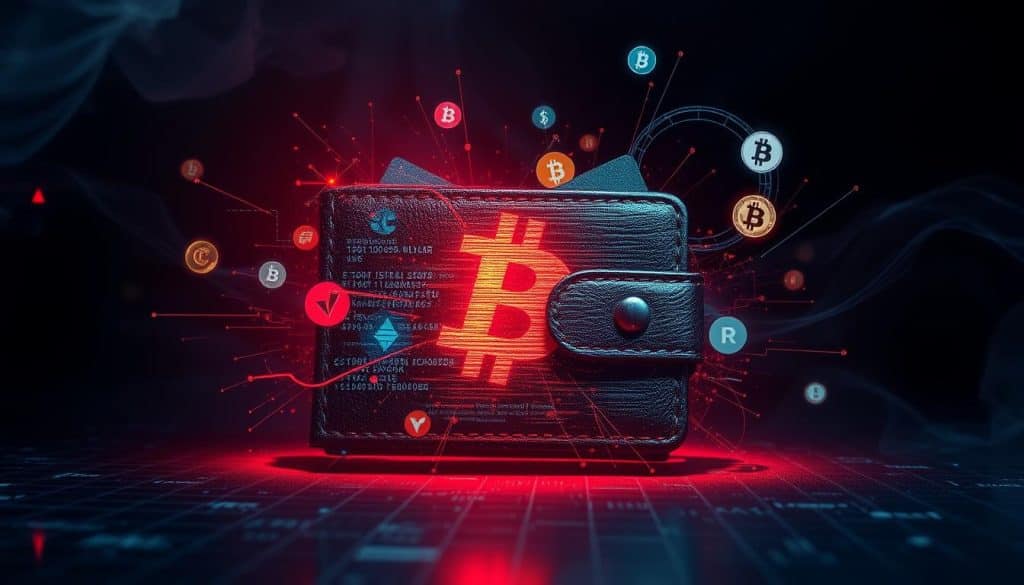From January to March 2022, cybercriminals stole more than $1.3 billion in cryptocurrencies. This shows the growing threats against crypto wallet users1. As more people use digital currencies, scammers find new ways to attack2. It’s crucial to keep your crypto wallet safe as hackers become smarter2.
Today, less than 1% of crypto transactions are illegal, down from 35% in 2012. This drop is due to strong AML policies2. But, the danger is still there. Once a crypto wallet is hacked, it’s usually hacked for good2. Here are seven signs that your crypto wallet might be in danger.
Key Takeaways
- The FBI reported over $1.3 billion stolen in cryptocurrencies in just the first quarter of 20221.
- Scammers continually create new methods to compromise your crypto wallet2.
- Compromised crypto wallets often remain compromised indefinitely2.
- Investment scams and phishing scams are prevalent, targeting crypto users through various communication channels1.
- Regular security checks and enabling two-step authentication can greatly enhance your crypto wallet security2.
- Effective AML and KYC policies have significantly reduced financial crime in the crypto space2.
Introduction to Crypto Wallet Security
Cryptocurrencies are getting more popular, and with that, the risk of cyberattacks on crypto wallets rises. Many people have lost a lot of money because their wallets were hacked. It’s crucial to know how to keep your crypto wallet safe.
Biometric authentication uses things like fingerprints or facial recognition for safe access to wallets. Multi-factor authentication (MFA) adds more security by asking for several proofs of identity, like passwords and biometrics. With encryption, these methods keep private keys safe and protect data3.
Secure Element (SE) technology in hardware wallets keeps private keys safe from online threats. Decentralized identity check lets people prove who they are without giving away private info. Working with Decentralized Exchanges (DEXs) makes transactions secure and prevents hacks. Following Know Your Customer (KYC) rules and global regulations helps fight fraud in crypto and Decentralized Finance (DeFi) sectors3.
In May, scammers made over 7,905 fake blockchain wallets to steal cryptocurrencies. Ice phishing attacks, making up 55.8% of May’s attacks, pose a big threat. These scammers trick people by taking control of their assets in sneaky ways4. Another trick, “address poisoning,” confuses users with tiny transactions to a fake address4.
Scammers also pretend to be famous brands to trick people in social engineering attacks. For instance, they targeted Chainlink (LINK) holders with a fake tLINK token. They send fake tokens in a real-looking giveaway to steal from people. Forta helps by using bots and machine learning to flag risky wallets and monitor for scams like “security update”4.
Signs of Unusual Transaction Patterns
Keeping an eye on your crypto wallet is very important to stay safe. Knowing when your wallet might be at risk is key. This knowledge lets you act fast to protect your money.
High-Value Transfers Over Short Periods
One warning sign is a lot of big transfers in a short time. If you see many large moves happening quickly, be wary. It might mean someone unauthorized is accessing your wallet and trying to take your funds fast.
Structured Transactions Below Reporting Thresholds
Some try to avoid detection by making transactions small enough not to be reported. At first, these transactions might look normal. But looking closer, they show a pattern aimed at avoiding legal attention. Seeing this pattern could mean your wallet is being used wrongly or for illegal activities like money laundering5.
Conversion to Numerous Currencies with High Fees
Switching crypto into different currencies, especially with high fees, is another red flag. This method can hide where the money originally came from. If you notice these costly swaps, be alert. It’s not what normal users do and may point to money laundering using your wallet6.
Being aware and on the lookout for these odd patterns can help protect your crypto. Spotting these early can prevent big losses and keep your assets secure.
Monitoring Geographical Risks
Keeping a close watch on geographical risks is key for strong crypto wallet security. It includes being alert to transfers to places with low regulation, spotting addresses in countries lacking AML rules, and noting odd cross-border moves. These steps help follow AML rules and keep KYC processes secure.
Transfers to Low Regulation Areas
Money launderers target areas with poor AML rules using exchanges based there. This risks your crypto wallet’s security. The European Central Bank (ECB) stresses the need for precise monitoring to ensure data is both accurate and consistent7. Watching these transfers closely can strengthen your asset’s security.
Addresses in Countries Without Sufficient AML Regulations
The ECB uses third-party data to watch over crypto-assets, focusing on network sizes and market values7. It’s vital to track addresses in countries with loose regulations to stay AML compliant. Despite data challenges, using trustworthy info is crucial for the crypto sector’s regulation7.
Suspicious Cross-Border Transfers
Cross-border transfers need extra caution, especially when sender and receiver are from different countries than their exchanges. These moves might try to skirt strict AML laws. The ECB encourages using detailed data alongside aggregated data for effective monitoring7. Identifying such activities boosts your wallet’s security and meets KYC standards.
Suspicious User Profiles and Behaviors
Spotting suspicious user profiles and their actions is key to catching a hacked crypto wallet. Look out for things like mismatched IP addresses and a single IP managing many wallets. These signs point to possible identity theft in the crypto world. For instance, witnessing transactions to bad addresses or frequent updates in contact info might mean the wallet is at risk.
Statistics show why we must stay alert. Over 300,000 people were tricked by phishing in the crypto sector in 2022, losing $52.1 million together8. In 2023, scams still happened, with 298,000 victims losing more than $18.7 million8. When a single IP handles many wallets, it could signal identity theft. British police seized about $250 million in crypto from scams9.
Interestingly, under 1% of all crypto transactions now are illegal, a sharp drop from 35% in 20129. This decrease shows better rules but reminds us to watch for shady profiles carefully. Dealing with shady cryptocurrencies or darknet markets, plus spending beyond one’s means, could hint at a compromised wallet9.
- Frequent changes in contact and identification information
- Transactions involving illicit addresses
- Multiple wallets controlled by a single IP address
- Unusual high-value transactions inconsistent with user’s financial profile
In 2019, crooks hid $2.8 billion using crypto exchanges9. With such huge sums, staying watchful is crucial. Big purchases that don’t match a user’s usual spending should worry us. By keeping track of these warning signs, we can fight identity theft in crypto and protect our wallets.
Anonymity and Privacy Risks
Cryptocurrencies offer anonymity, but this feature brings security risks, especially when people use privacy coins. Coins like Monero, Zcash, and Dash make transactions hard to track. They hide all transaction details, increasing the anonymity risks in crypto10.
Use of Privacy Coins
The use of privacy coins is growing. These coins hide how much money is moved and who is involved in transactions10. Monero, for example, is popular in hidden markets for its strong privacy10. Privacy is key for many, but it can also lead to wrong use and security issues.
High-Value Transactions on P2P Platforms
High-value crypto trades are becoming common on peer-to-peer platforms. These sites don’t have strict rules like banks, making them less secure. It’s harder to spot illegal activities, adding to anonymity risks in crypto10.
These platforms often use special methods and tools to keep users anonymous. Tracking transactions becomes even more difficult10.
Usage of Proxies or VPNs
People use proxies or VPNs to hide their online addresses during crypto trades. VPNs like ExpressVPN and NordVPN protect users’ identities. They make it tough to trace transactions back to the users10. The Tor network also helps by encrypting data across many places10. These tools are great for privacy but can also help in illegal acts, making it hard to find risks of high-value crypto transactions without being caught10.
These methods offer privacy but create challenges for those looking to keep crypto markets safe and clear. Finding a balance between privacy and security needs careful thought and constant attention.
Red Flags in Source of Funds
Scrutinizing the source of funds helps identify compromised wallets. Funds linked to darknet markets, illegal betting, or stolen money are major concerns. Financial entities and regulators need to monitor these suspicious activities closely. The Financial Action Task Force (FATF) lists 42 red flags for Virtual Asset Service Providers to watch out for here11. These include unusual geographic risks and odd transactions, like moving large sums from unknown third parties11.
Large deposits quickly turned into privacy coins suggest hiding illicit funds. Five key customer due diligence (CDD) steps help identify these red flags. They involve identifying owners, understanding the business relationship, and knowing the fund’s origin11.
Funds from Known Illicit Actors
Dealing with funds from known crime sources is a huge worry. This money may stem from bribery, tax crimes, or fraud11. The FATF outlines various laundering methods, including using client accounts wrongly and front companies. OneCoin shows the risks of centralized control and lack of clarity12. It’s hard to withdraw these funds, raising more doubts12.
Substantial Deposits Converting Directly to Privacy Coins
Turning big deposits straight into privacy coins raises flags. It hides the funds’ origins using coin anonymity, indicating potential laundering. Quick, large transactions without a clear purpose are suspicious11. The FATF has categorized six laundering types, stressing the need for strict anti-laundering measures13. Watching for suspicious transactions and issues, like high fees or fast timeline conversions, can spot exploitation11.
Rising Crypto Hacks and Scams
The scary rise in crypto hacks and wallet scams highlights the risks in digital markets. In 2023, people lost almost $2 billion to scams, with each victim losing about $28,00014. Crypto payments are second only to bank transfers in loss amounts14.
Phishing scams try to snatch account details, including crypto keys. They cost people big money15. Over 46,000 people reported losing more than $1 billion in crypto from 2021 to early 202215. Also, crypto romance scams tricked folks out of $139 million last year15.
The Lumma Stealer malware, which targets crypto, saw its detection triple in 202316. In February, victims lost $47 million to phishing scams aimed at crypto wallets16.
SIM-swap scams let attackers get into crypto wallets secretly. Also, fake crypto exchanges and wallets trick users with low prices. But when users try to withdraw, they find their money gone15. This world of crypto threats means people must use strong protection for their assets.
How to Protect Your Crypto Wallet
Keeping your crypto wallet safe is key in the online world. With the right steps, you can really boost your digital money’s safety.
Enable Two-Factor Authentication
Two-factor authentication (2FA) adds an extra safety layer to your wallet. It combines a password with something like a code texted to you. This makes it harder for others to get in without permission.
Use Strong and Unique Passwords
It’s crucial to pick tough passwords for your wallet. Make sure your password is not something easy or common. A strong, unique password stops hackers from breaking in through force17.
Securely Store Seed Phrases
Keeping your seed phrases safe helps you get back into your wallet if something goes wrong. The best way is to write them down and keep them somewhere safe offline. This keeps hackers away and protects your crypto cash18.
By following these tips, like using secure passwords and keeping seed phrases safe, you build a strong wall against theft. For tips on keeping your investments safe, see the advice from crypto experts.
The Importance of Regular Software Updates
Keeping your crypto wallet software up to date is key for safety. The updates often have important security fixes. These tackle weaknesses that hackers use, lowering the chance of attacks on old software19. New threats pop up all the time in the crypto world. So, having the latest security is crucial19.
Your wallet needs to stay in sync with blockchain updates to keep your money safe19. Skipping updates can lead to many problems. Like unauthorized access, lost funds, or damage to your crypto assets19. In fact, 60% of breaches are because of not updating20.
Updating your crypto wallet is a top security tip19. These updates fix bugs and bring in new things to make managing your digital money better19. Sadly, less than 20% of people update their wallets often enough to fix these issues20.
Security patches are super important. They solve big and small problems. Like stopping malware and keyloggers from getting into your wallet21. Or making hardware wallets safer with better protection21. Keeping updated also stops hackers who use simple tricks like guessing passwords or using broken devices21.

In the end, doing regular updates and patches is key for protecting your digital money. Make sure your wallet software is always current. This gives you the best defense.
Conclusion
Keeping your cryptocurrency wallet safe is very important in today’s digital world. Watch out for signs like unexpected transactions or many failed login tries22. Use features like two-factor authentication (2FA) and create strong, unique passwords to prevent unapproved access23.
Avoid using public Wi-Fi for important transactions and stay up-to-date on the latest scams. An FBI report showed over 800,000 Americans were tricked online last year, losing more than $10.2 billion23. These numbers highlight why it’s critical to be always watchful and adopt solid security measures for your crypto23.
To protect your assets in the long run, keep your seed phrases safe with physical backups like Coinplate, which can survive fire and water damage22. Learn about the risks of smart contracts and keep your seed phrases secret to avoid big losses. Check out this link for more on keeping your crypto wallet secure. Be smart and proactive in protecting your digital money.
























 Bitcoin
Bitcoin  Ethereum
Ethereum  Tether
Tether  XRP
XRP  USDC
USDC  Wrapped SOL
Wrapped SOL  Lido Staked Ether
Lido Staked Ether  TRON
TRON  Dogecoin
Dogecoin  Cardano
Cardano  Figure Heloc
Figure Heloc  WhiteBIT Coin
WhiteBIT Coin  Wrapped stETH
Wrapped stETH  Bitcoin Cash
Bitcoin Cash  Wrapped Bitcoin
Wrapped Bitcoin  Chainlink
Chainlink  USDS
USDS  Hyperliquid
Hyperliquid  LEO Token
LEO Token  Binance Bridged USDT (BNB Smart Chain)
Binance Bridged USDT (BNB Smart Chain)  WETH
WETH  Stellar
Stellar  Wrapped eETH
Wrapped eETH  Monero
Monero  Ethena USDe
Ethena USDe  Zcash
Zcash  Coinbase Wrapped BTC
Coinbase Wrapped BTC  Litecoin
Litecoin  Avalanche
Avalanche  Sui
Sui  Hedera
Hedera  Shiba Inu
Shiba Inu  Dai
Dai  World Liberty Financial
World Liberty Financial  sUSDS
sUSDS  Cronos
Cronos  USDT0
USDT0  Toncoin
Toncoin  PayPal USD
PayPal USD  Uniswap
Uniswap  Polkadot
Polkadot  Ethena Staked USDe
Ethena Staked USDe  Mantle
Mantle  Aave
Aave  Bittensor
Bittensor  USD1
USD1  Canton
Canton  Bitget Token
Bitget Token